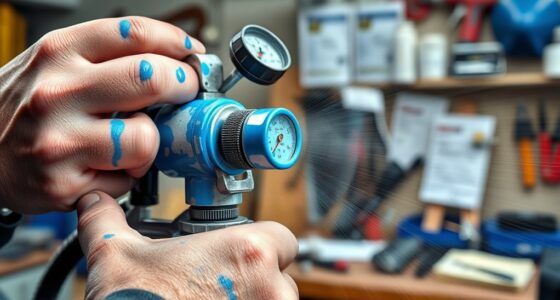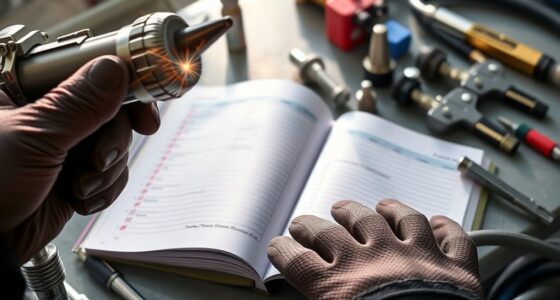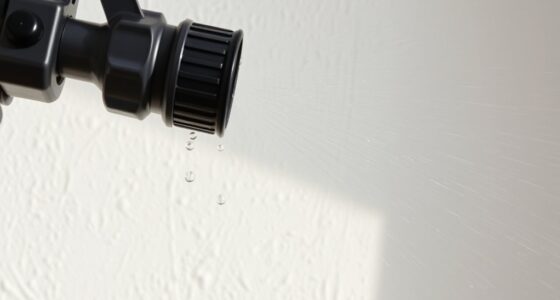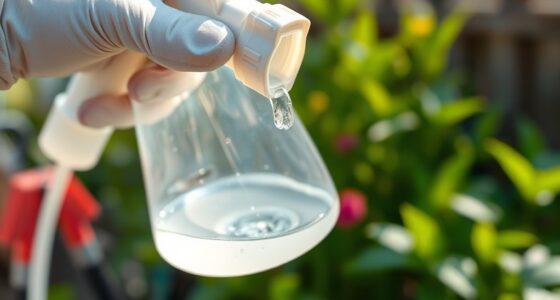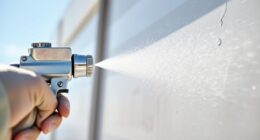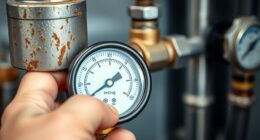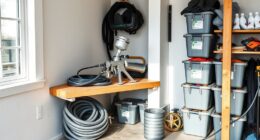To fix inconsistent spray patterns like tails and fingers, start by inspecting and cleaning your nozzle thoroughly, replacing any worn parts. Adjust your gun’s fluid, air, and fan controls to achieve a balanced, smooth pattern, and always calibrate regularly to prevent distortion. Keep your equipment well-maintained and monitor environmental conditions like humidity. Follow these steps carefully, and you’ll discover how small tweaks can lead to a professional, tail-free finish.
Key Takeaways
- Clean and inspect the spray nozzle regularly to prevent blockages and ensure even spray flow.
- Adjust fluid and air flow settings to eliminate tails and fingers, maintaining a consistent pattern.
- Calibrate the spray pattern for proper shape, focusing on fan width and pattern shape adjustments.
- Replace worn or damaged nozzles promptly to avoid irregular spray tails and finger formations.
- Practice testing on scrap material to fine-tune equipment and develop a steady, uniform spray pattern.
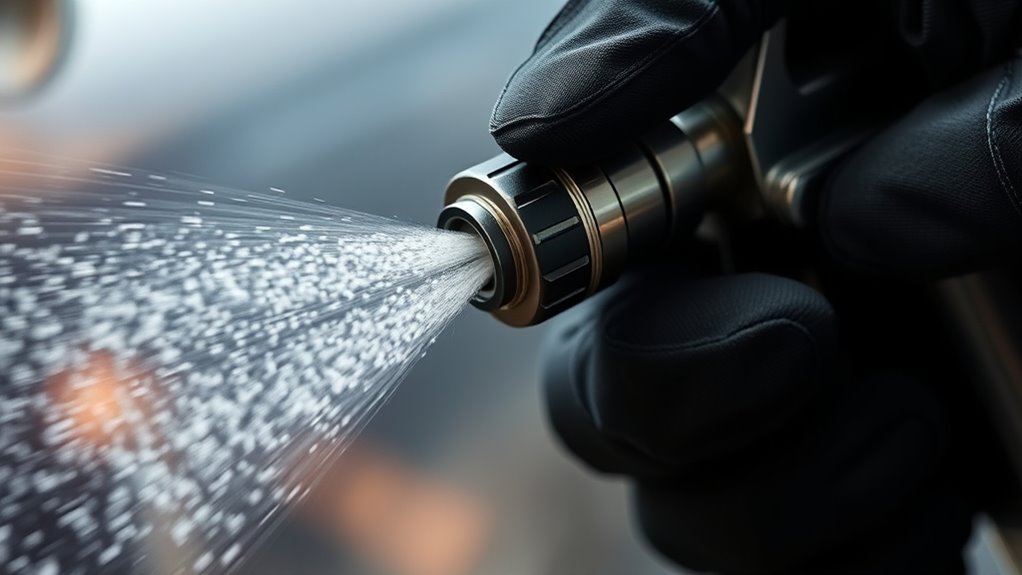
If you’ve noticed uneven or unpredictable spray patterns, it’s likely due to blockages or wear in your spray nozzle. These issues can cause tails, fingers, or inconsistent coverage that hampers your work. To fix this, start by focusing on spray pattern calibration, which guarantees your gun produces the correct spray shape. Proper calibration involves adjusting your equipment so that the spray pattern matches the intended design, whether it’s a round, fan, or irregular shape. When your spray pattern isn’t calibrated correctly, you’ll see uneven edges, excessive tails, or gaps in coverage. Regularly checking and adjusting your spray pattern can help prevent these problems and improve the quality of your finish.
Gun adjustment techniques are essential for correcting inconsistent spray patterns. Most spray guns have controls that allow you to modify fluid flow, air pressure, and fan width. Begin by adjusting the fluid control to ensure it’s not too high or too low; too much fluid can cause drips and tails, while too little results in uneven coverage. Next, tweak the air pressure, which influences atomization and pattern shape. Higher pressure produces a finer spray but can also create tails if not balanced correctly. The fan adjustment controls the width of the spray pattern—narrower for detail work, wider for larger surfaces. Fine-tuning these settings ensures your spray pattern remains consistent and smooth.
If your spray pattern still shows tails or fingers after initial adjustments, consider cleaning or replacing the nozzle. Blockages or wear in the nozzle can distort the spray, leading to uneven edges and tails. Remove the nozzle carefully, clean it with a suitable solvent, and inspect for damage or buildup. Sometimes, replacing a worn nozzle is the most effective solution. Regular maintenance, including cleaning and inspecting your spray equipment, helps maintain ideal spray pattern calibration. Remember, small adjustments can make a significant difference, so take your time to dial in the settings precisely.
Additionally, practicing your gun adjustment techniques on scrap material can help you understand how each change influences the spray pattern. Consistent testing allows you to develop a feel for the right balance of fluid, air, and fan settings. Over time, this will lead to more uniform spray patterns, fewer tails, and cleaner finishes. Keep in mind that environmental factors like humidity and temperature can also affect spray behavior, so adjustments may be necessary depending on conditions. Proper equipment maintenance and careful calibration are crucial for achieving a professional finish. By paying close attention to these details and maintaining your equipment properly, you’ll ensure your spray patterns stay consistent, professional, and free from tails or fingers.
Frequently Asked Questions
How Do Environmental Factors Affect Spray Pattern Consistency?
Environmental factors critically impact spray pattern consistency. Airflow interference, like gusts or drafts, disrupts your spray, causing tails or uneven fingers. Surface texture effects also matter; rough or uneven surfaces can alter spray distribution, making it less uniform. To maintain consistency, make sure a stable environment with minimal airflow interference and work on smooth, even surfaces. This helps your spray pattern stay precise and predictable, improving your overall results.
Can Nozzle Wear Cause Inconsistent Spray Patterns Over Time?
Yes, nozzle wear can cause spray inconsistency over time. As your nozzle wears out, it creates irregularities in the spray pattern, leading to uneven coverage or tails. You might notice a decrease in spray quality and more inconsistent results. Regularly inspecting and replacing worn nozzles guarantees consistent spray patterns, helping you achieve smooth, even application and avoiding issues caused by nozzle wear.
Are There Specific Cleaning Techniques for Different Spray Equipment?
Yes, there are specific cleaning techniques for different spray equipment. You should follow proper cleaning protocols tailored to each nozzle type, ensuring thorough removal of paint residues and debris. Regular nozzle maintenance is essential; use appropriate brushes and cleaning solutions to prevent blockages and wear. Always consult manufacturer guidelines to avoid damage, and clean your equipment after each use to maintain consistent spray patterns and prolong nozzle lifespan.
How Often Should Spray Equipment Be Calibrated for Optimal Performance?
You should calibrate your spray equipment regularly—typically every 2 to 4 weeks—to guarantee ideal performance. Skipping calibration can lead to inconsistent spray patterns, affecting your results. Keep in mind, calibration frequency is crucial for ongoing equipment maintenance, preventing costly errors. Always stay proactive; neglecting this step may cause uneven coverage or wasted materials. Trust me, consistent calibration is the key to flawless finishes every time.
What Are the Signs of a Malfunctioning Spray Pattern?
You’ll notice a malfunctioning spray pattern if you see uneven coverage, drips, or excessive overspray. During spray pattern diagnostics, look for inconsistent or distorted spray shapes. Troubleshooting techniques include checking nozzle alignment and cleaning, inspecting for clogs, and adjusting pressure settings. If issues persist, recalibrate your equipment. Recognizing these signs helps you quickly identify problems and maintains a smooth, uniform finish for your project.
Conclusion
By mastering these tips, you’ll transform your spray patterns from jagged lightning bolts into smooth, steady rivers. Think of your spray as a brushstroke—consistent and controlled—rather than a wild storm. With patience and practice, you’ll tame those tails and fingers, turning chaos into harmony. Keep refining your technique, and soon your spray will flow like a well-oiled engine, delivering flawless results every time. Remember, persistence is the key to turning your spray pattern into a masterpiece.



